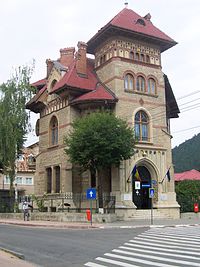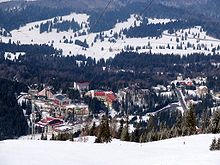Suceava, the gate to the painted monasteries
Bucovina, the upper northern part of the Romanian Moldavia, is a wonderful hill land,scattered with many painted monasteries build in the middle age, mainly by the well known legendary ruler Stephen the Great (1457-1504).
 |
| Suceava Fortress, residence of Stephen the Great and capital of Moldavia |
Stephen the Great is still living today, being subject to many jokes, proving his strong influence in all Romanian history. The history fact is that he was an exponent of a new ascending country, namely Moldavia, and he managed to keep a certain independence of Moldavia, despite its many enemies ( Turks, Polish, Hungarians etc). His capital was in Suceava, look anyway for the fortress of Suceava (Cetate).
 |
| City Hall from Suceava is a good example of Secession style |
The fortress of Suceava is very strong, and from here Moldavia has been ruled for centuries. On unknown reasons, in the XVII th the fortress of Suceava was left and deserted, but even nowadays, after successful restaurations, is very impressive. The walls are 20 meters high and 2 meters thick, and you can try climbing then during your visit (there is a small fee to be paid). From the fortress you have a good sight to the all city, and decide what else to do here.
 |
| The interesting railway station from Suceava, in my opinion one of the nicest in Romania |
Suceava has today 100000 inhabitants, among them a few Rusians, Ukrainians, Lipovans and Polish (more than 90 % are Romanians). Suceava was a century ruled by the Habsburgic empire, and you can still find some things to remember, e.g. the Catholic Church. Orthodoxes Curches are much more, but you may not miss the Miclauti Church, where for centuries the Moldavia's ruler have been appointed and crowned. Observe there the ingenious positioning of the bell, which is not in a separate tower, but included in the front wall.
 |
| The orthodox church of Miclauti, Suceava where for centuries the Moldavian Rulers have been appointed and crowned |
You also can't miss the horse statue of Stephen the Great, dominating the city, and the railway station with its 100 years old architecture, one of the most beautiful in Romania.
Suceava is maybe the only city in Bucovina, and has an important tourist circulation. The offer on hotels and restaurants is wide and generous. I would suggest you Hotel and Restaurant Bucovina, and the restaurant Casa Arcasului, for the good balance quality and price (the both are high end category).
From Suceava you can make daily trips to the painted monasteries, one of the most important things to see in all Romania. But you need nevertheless at least another day to visit Suceava Museums: Ethnography Museum, History Museum, Art Museum. Men, you are going to like and love Suceava for sure.






































.jpg)










